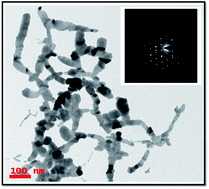Silver nanoribbons achieved by picosecond ablation using cylindrical focusing and SERS-based trace detection of TNT
Abstract
We report the fabrication of silver nanoribbons by picosecond laser ablation of bulk silver (Ag) targets submerged in double distilled water (DDW) using a cylindrical focusing geometry. The laser ablation was performed by ∼2 picosecond laser pulses and the corresponding light sheet engendered by a cylindrical lens of focal length ∼4.5 cm. The input pulse energies employed at a wavelength ∼800 nm in the experiments were ∼1000 μJ, ∼1200 μJ, and ∼1400 μJ. In contrast to the case of ablation with spherical lenses, cylindrical lens ablation produced nanoparticles (NPs) and nanostructures (NSs) in 20% less time. The data obtained from the optical characterizations exemplify that localized surface plasmon resonance (LSPR) was observed at 406 nm, 408 nm, and 410 nm for the input energies of ∼1000 μJ, ∼1200 μJ, and ∼1400 μJ, respectively. Interestingly, it was observed that the ablation performed at an input energy of ∼1200 μJ demonstrated the fabrication of Ag nanoribbons rather than the formation of Ag NPs. Selected area electron diffraction (SAED) data of the nanoribbons recorded revealed their crystalline phase and linear morphology. Ag nanomaterials (NPs and ribbons) synthesized in these experiments were employed to detect the explosive molecules of 2,4,6-trinitrotoluene (TNT) at a concentration 25 nM using the technique of surface enhanced Raman scattering. The enhancement factor in the case of Ag nanoribbons (width of ∼20–30 nm, length of ∼0.6–2 μm), obtained using the cylindrical focussing geometry at input pulse energies of ∼1200 μJ, was estimated to be ∼107 for the 1362 cm−1 mode, corresponding to the symmetric NO2 stretch of TNT.



 Please wait while we load your content...
Please wait while we load your content...